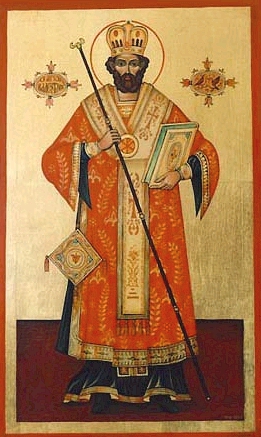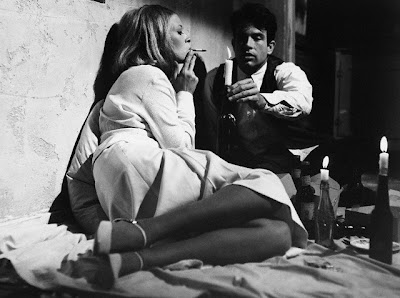
The Legend of St. Valentine
February has long been celebrated as a month of romance, and St. Valentine's Day, as we know it today, contains vestiges of both Christian and ancient Roman tradition. But who was Saint Valentine, and how did he become associated with this ancient rite?
One legend contends that Valentine was a priest who served during the third century in Rome. When Emperor Claudius II decided that single men made better soldiers than those with wives and families, he outlawed marriage for young men. Valentine, realizing the injustice of the decree, defied Claudius and continued to perform marriages for young lovers in secret. When Valentine's actions were discovered, Claudius ordered that he be put to death.
One legend contends that Valentine was a priest who served during the third century in Rome. When Emperor Claudius II decided that single men made better soldiers than those with wives and families, he outlawed marriage for young men. Valentine, realizing the injustice of the decree, defied Claudius and continued to perform marriages for young lovers in secret. When Valentine's actions were discovered, Claudius ordered that he be put to death.

According to one legend, an imprisoned Valentine actually sent the first "valentine" greeting himself after he fell in love with a young girl--possibly his jailor's daughter--who visited him during his confinement. Before his death, it is alleged that he wrote her a letter signed "From your Valentine," an expression that is still in use today. Although the truth behind the Valentine legends is murky, the stories all emphasize his appeal as a sympathetic, heroic and--most importantly--romantic figure.
By the Middle Ages, perhaps thanks to this reputation, Valentine would become one of the most popular saints in England and France.
Origins of Valentine's Day: A Pagan Festival in February
The Christian church may have decided to place St. Valentine's feast day in the middle of February in an effort to "Christianize" the pagan celebration of Lupercalia. Celebrated at the ides of February, or February 15, Lupercalia was a fertility festival dedicated to Faunus, the Roman god of agriculture, as well as to the Roman founders Romulus and Remus.
To begin the festival, members of the Luperci, an order of Roman priests, would gather at a sacred cave where the infants Romulus and Remus, the founders of Rome, were believed to have been cared for by a she-wolf or lupa. The priests would sacrifice a goat, for fertility, and a dog, for purification. They would then strip the goat's hide into strips, dip them into the sacrificial blood and take to the streets, gently slapping both women and crop fields with the goat hide. Far from being fearful, Roman women welcomed the touch of the hides because it was believed to make them more fertile in the coming year. Later in the day, according to legend, all the young women in the city would place their names in a big urn. The city's bachelors would each choose a name and become paired for the year with his chosen woman. These matches often ended in marriage.
Valentine's Day: A Day of Romance
At the end of the 5th century, Pope Gelasius declared February 14 St. Valentine's Day. It was not until much later, however, that the day became definitively associated with love. During the Middle Ages, it was commonly believed in France and England that February 14 was the beginning of birds' mating season, which added to the idea that Valentine's Day should be a day for romance.
Typical Valentine's Day Greetings
In Great Britain, Valentine's Day began to be popularly celebrated around the 17th century. By the middle of the 18th, it was common for friends and lovers of all social classes to exchange small tokens of affection or handwritten notes, and by 1900 printed cards began to replace written letters due to improvements in printing technology. Ready-made cards were an easy way for people to express their emotions in a time when direct expression of one's feelings was discouraged. Cheaper postage rates also contributed to an increase in the popularity of sending Valentine's Day greetings.

Americans probably began exchanging hand-made valentines in the early 1700s.
Americans probably began exchanging hand-made valentines in the early 1700s.
Famous Lovers
Vatsyayana
author of the Kama Sutra
This ascetic, probably celibate scholar who lived in classical India (around the 5th century A.D.) is an unlikely candidate to have written history's best known book on erotic love. Little is known about Vatsyayana's life, but in his famous book — actually a collection of notes on hundreds of years of spiritual wisdom passed down by the ancient sages — he wrote that he intended the Kama Sutra as the ultimate love manual and a tribute to Kama, the Indian god of love.
Giacomo Casanova
Born in Venice in 1725 to actor parents, Casanova was expelled from a seminary for scandalous conduct and embarked on a varied career, including a stint working for a cardinal in Rome, as a violinist, and as a magician, while traveling all around the continent. Fleeing from creditors, he changed his name to Chevalier de Seingalt, under which he published a number of literary works, most importantly his autobiography. Casanova's celebration of pleasure seeking and much-professed love of women — he maintained that a woman's conversation was at least as captivating as her body — made him the leading champion of a movement towards sexual freedom, and the model for the famous Don Juan of literature.
| Venus |
The famous French chanteuse with the throaty voice became the epitome of classic Parisian-style romance for her legions of fans. Born Edith Giovanna Gassion in 1915, she was abandoned by her mother and reared by her grandmother; while traveling with her father, a circus acrobat, she began singing for pennies on the street. Discovered by a cabaret promoter who renamed her Piaf, or "sparrow," Edith enjoyed a meteoric rise to stardom and by 1935 was singing in the grandest concert halls in Paris. Piaf was married twice, but her great love was the boxer Marcel Cerdan, a world middleweight champion who was killed in a plane crash en route from Europe to New York in 1949. It was for Cerdan that Piaf sang the achingly romantic "Hymne a l'amour,"(link) celebrated all over the world as one of her best loved ballads.
Leonard Cohen
(Click above)
While giving the speech at Cohen's induction into the Rock and Roll Hall of Fame on 10 March 2008, Lou Reed described Cohen as belonging to the "highest and most influential echelon of songwriters."
Romeo and Juliet

Bonnie and Clyde

No comments:
Post a Comment